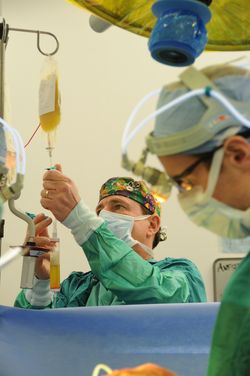 Despite their use in approximately 60,000surgeries per day in the U.S. alone, medical researchers don’t know exactly howanesthetics cause unconsciousness – or what the true long-term impact of theiruse could be on the brain and the rest of the body.
Despite their use in approximately 60,000surgeries per day in the U.S. alone, medical researchers don’t know exactly howanesthetics cause unconsciousness – or what the true long-term impact of theiruse could be on the brain and the rest of the body.
"The development of anesthetic drugs hasbeen hailed as one of humankind's greatest discoveries in the last thousandyears," Max B. Kelz, MD,PhD, assistant professor of Anesthesiology and Critical Care, said in arecent US News & World Report article."Anesthetics are annually given to over 230 million patients worldwide.Yet as a society, and even within the anesthesia community, we seem to havelost our curiosity for how and why they work."
But research advances by Dr. Kelz and otherfaculty in the Penn MedicineCenter for Anesthesia Research, one of the largest programs of its kind inthe world, are helping to get to the bottom of this 160-year-old mystery.
With regard to pinpointing how anestheticscause a state of unconsciousness, Kelz focuses his work on the overlap betweenthe neurobiology of sleep and anesthesia. In October, his research teampublished a paper in Current Biology that showed in an animal model certainanesthetics don't just turn wakefulness "off," they also forceimportant sleep circuits in the brain "on," essentially hijacking ournatural sleep circuitry.
In this study, Kelz and colleagues focused on aparticular part of the brain, deep within the hypothalamus, which is known toincrease in activity as one drifts off to sleep. Through a combination ofdirect electrical recording and other methods, they found that isoflurane – atype of anesthetic – boosts activity in this sleep-promoting brain area inmice. As further evidence of a connection, animals lacking the function ofthose neurons exhibited acute partial resistance to entering states ofanesthesia.
Dr. Kelz and his team also published another paper in the November issue of the journal Anesthesiology that looked at a specific anestheticdrug called dexmedetomidine – primarilyused in operating rooms and intensive care units in hospitals because itinduces a state of anesthesia that is most similar to that of naturalsleep. “If we can determine exactly where and how a medication such asdexmedetomidine works to cause unconsciousness, that unique drug may providebetter clues into the workings of other anesthetics, as well as insights intocontrol and regulation of natural sleep,” he says.
In the area of long-term consequences ofanesthetics on the brain and the rest of the body, Roderic Eckenhoff, MD,Austin Lamont Professor of Anesthesia and neuroscientist Maryellen Eckenhoff, PhD, investigate theinteraction between anesthesia, surgery, neuroinflammation, and chronicneurodegenerative disorders, such as Alzheimer's disease. In a human study published last year that examined Alzheimer'sbiomarkers found in cerebral spinal fluid (CSF) after surgery, their team foundevidence that anesthesia and surgery may accelerate neurodegenerativedysfunction.
In order to separate anesthesia from surgery asthe culprit, the team performed a separate animal model study, published in September in Annalsof Surgery. In this study, the research team exposed mice withhuman Alzheimer’s disease genes to either anesthesia alone, or anesthesia andan abdominal surgery. “In the animals we studied, there was a clear andpersistent decrement in learning and memory caused by surgery as compared withinhalational anesthesia alone,” says Maryellen Eckenhoff. This paper is thefirst to indicate that surgery itself, more than anesthesia, is the trigger fordecline in patients with Alzheimer’s disease.
Both studies also suggest thatneuroinflammation has a profound impact on a dementia-vulnerable brain. “Morestudies will be needed to first confirm these findings and then begin to deployanti-inflammatory strategies to minimize injury,” adds Rod Eckenhoff. “As aprofession, doctors need to understand the long-term implications of our care,both positive and negative, and do all we can to delay the onset of dementia.”
Their group is also looking at how to developnewer anesthetics that won’t have the same neuroinflammatory impact as olderanesthetics. Rod Eckenhoff explains this research, done by studying differentcompounds in tadpoles, in a video interview with Chemistry & Engineering News.